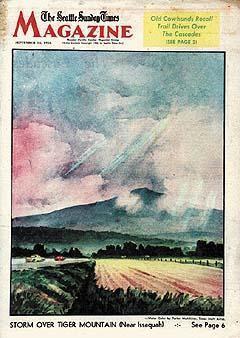
Tiger Mountain, as painted by Parker McAllister.
IN 1941, IRVING PETITE AND BILL MCCAULEY DEFIED ALL GOOD SENSE to buy a quarter section of stump land on Tiger Mountain, in Issaquah. When Petite first set up camp, he brought along two treasures: Thoreau's "Walden" and a typewriter.
He hoped to become a poet but ended up designing a cabin instead. Maybe, he wrote, building could be nearly the same thing as writing poetry. It turned out to be so for a man whose art was to pay careful attention to the ordinary.
Irving Petite reported bread-and-butter stories for The Times during the 1950s but he was really working at a different kind of prose. As his land began to heal itself, he guided its recovery with a gentle hand, gathering material for his nonfiction books and for his essays in The Times' Sunday magazine.
Once, an interviewer asked him why he had abandoned civilization for his mountain retreat. Smiling, he pointed out the wail of fire sirens below and the heavy drone of jet engines overhead -- the muffled drums of city life, as he put it. Seattle's bright lights were only 20 miles away.
In 1984, the Issaquah Thoreau put his place up for sale, fleeing the steady march up Tiger Mountain of homes and taxes, even of hikers and hang gliders. He told a Times reporter "There's no breath here," and left.
For more than 40 years, Petite tested the boundary between the tame and the wild. He reminded readers that love of the Northwest wilderness begins in their own backyards: with respect for native plants and animals, clean water and honest dirt; with a simple life -- good food you grow yourself, close friends and slowing down to pay attention.